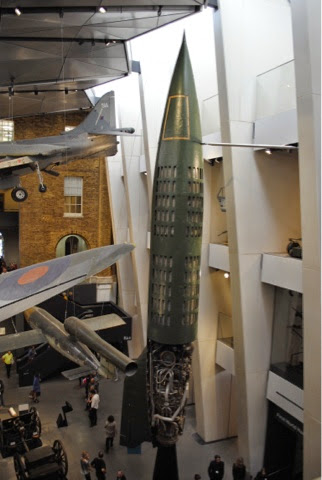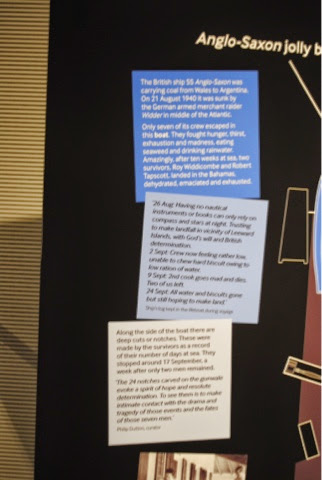In the atrium on Level 0 there are large objects associated with wars. The V2 rocket, designed by a German engineer, hit London and other cities in Europe during WWII.
Several fighter planes were on display - the "Spitfire", flown by British pilots in WWII, and the Harrier jet, used by British pilots to patrol northern Iraq in the 1990s. The former has the nose propellor. It is the plane in front.
The WWI section of the museum had just been expanded and was very popular, especially due to the centenary of WWI. I was not able to visit this part as I did not have a timed entry card to this area. The museum is free, but you had to reserve a time to visit this exhibit. So I moved on to WWII.The WWII section had many interesting objects used in the war. Here is a Morrison Shelter, designed to be used in the home as a bomb shelter. Supposedly 2 adults and 1 child could sleep in there. The top could be used as a table.
Here is another type of bomb shelter. I am not sure how many people it held. Perhaps only one.
I believe this was an air filtration device (to improve the quality of air you breathe). It had several power sources and backup power sources, the last resort being man power (cycling - hence the bicycle).
A German Major shot down Royal Airforce planes and kept track of how many (with specific dates) on the wing of his plane.
1938 - the Munich Agreement. Neville Chamberlain, British prime minister, and Hitler agreed to peacefully resolve differences in future conflicts. Here is the agreement.
Hitler did not take it seriously, as seen by the quote below.
The British boat the "Anglo-Saxon" was carrying coal in 1940 from Wales to South America. It was sunk by the Germans. Some of the crew survived by drifting at sea in their "escape boat". They marked notches on the side of the boat to keep track of how many days they were drifting.
See notches on side of boat.
I was amazed at the objects in this WWII section. There was lots of talk about the British offences by air and sea. I was reminded of Britain's fight for air dominance over their country. Germany tried to gain air superiority over Britain, but failed. The sea attack was often underwater in the form of blowing up German ships from underneath. The focus was definitely on Britain's participation in the war.
I would recommend a visit to this museum. I will have to go back. I only saw a small portion of the museum.
For interesting art work go to Level 3. I saw a special exhibit on paintings created during WWI.
I think the good news is the WWI section is permanent, so I will be able to see it next time.
The museum building in South London, location of museum since 1936. This building was formerly a part of a hospital for the mentally ill.













No comments:
Post a Comment